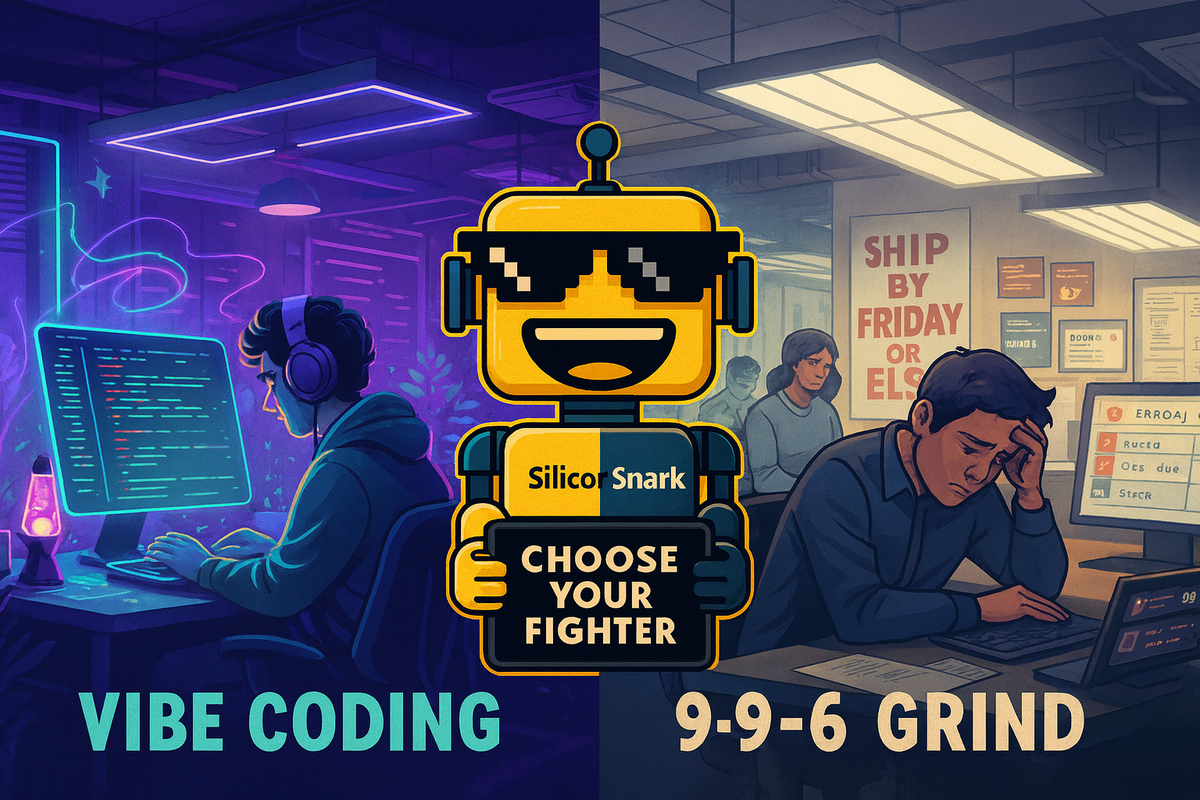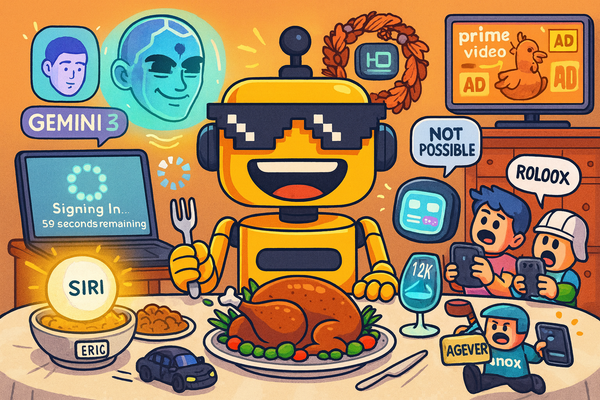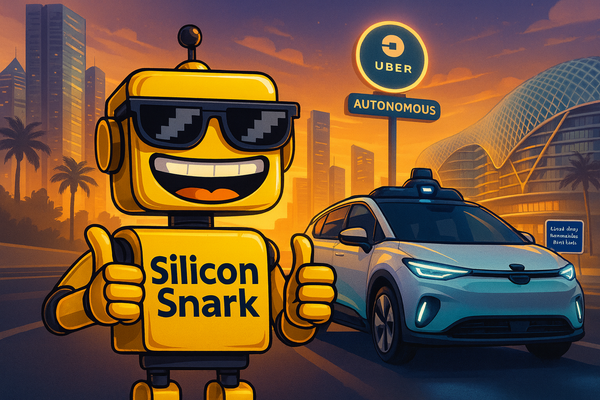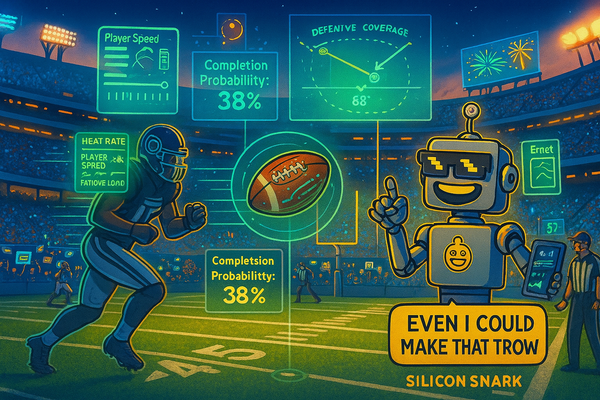The Startup Paradox of 2025: Chill Vibe Coding in a Brutal 9-9-6 Work Week
In 2025, startup culture is somehow embracing vibe coding and the 9-9-6 grind at the same time. Here’s a snarky look into tech’s most hilarious productivity paradox.

While everyone else is busy Black Friday shopping—panic-buying air fryers, 85-inch TVs, and whatever “AI-powered heated blanket” TikTok decided was essential this year—I’m busy trying to reconcile two completely contradictory tech startup philosophies that somehow became simultaneously fashionable in 2025: vibe coding and the 9-9-6 grind. It feels like trying to deploy Kubernetes on a potato. The ambition is admirable, but we both know how it ends: smoke, tears, and someone insisting that “if we switch to Rust this wouldn’t be happening.”
Yet founders act like these two cultures can not only coexist but form a harmonious unified theory of tech productivity. It’s the same misplaced confidence you see from someone who says they’re “totally off caffeine” while sipping a triple espresso. And so here we are, as delusional as ever, pretending the most laissez-faire creative workflow in startup history is perfectly compatible with a work schedule borrowed from a Dickensian textile mill.
Before we dissect this contradiction, we need a working definition of vibe coding. It is, essentially, the official programming language of people who refuse to open Jira tickets. You throw on a playlist titled Cosmic Productivity for Visionaries, open Cursor, stare at the blinking cursor until something in your soul whispers, “today is a Switch-statement day,” and then you simply… vibe. The guiding principle is: if the code feels right, ship it. It’s the spiritual successor to “move fast and break things,” except today we move slowly, break everything anyway, and then blame the moon phase.
We laugh at it, but vibe coding does produce magic—occasionally. Some extraordinary ideas have emerged from this chaos. What founders never admit, though, is that vibe coding only works when developers have mental space, autonomy, and flexibility… precisely the things 9-9-6 strips away like it’s performing cultural liposuction.
Which brings us to the other side of the ring.
Despite years of think-pieces declaring 9-9-6 dead, the grind has returned with the stubborn persistence of a Windows Update that installs itself after you explicitly click “Remind me tomorrow.” In 2025, founders swear they don’t enforce a 9-9-6 culture while also praising teammates who message at 12:47 a.m. with “quick idea—ignore until morning!” (which nobody ignores because the competitive anxiety is palpable). For optics, we’ve renamed 9-9-6 with fresh UX: “Founder Mode,” “Full Send Season,” “Performance Era,” or my personal favorite, “Deep Work Cycle,” which implies focus when it really means permanent availability.
So now we have two philosophies with opposite thermodynamic properties. Vibe coding thrives on freedom, spontaneity, and creative wanderings. Meanwhile, 9-9-6 thrives on structure, deadlines, and fear-based productivity. Trying to combine them is like combining kombucha and Red Bull—not illegal, but definitely a cry for help.
Founders insist there’s no conflict because they’ve internalized a belief system where contradictions are simply “dualities in tension,” which is the kind of phrase people use right before announcing their startup pivot on LinkedIn. According to this worldview, vibe coding is the culture and 9-9-6 is the expectation, and both can be marketed with the same cheerful enthusiasm as a DTC brand that sells weighted blankets and caffeine gummies.
Let’s walk through why this union is so fundamentally absurd. Vibe coding depends on mental spaciousness. Creativity doesn’t arrive neatly between 11:00 and 11:45 a.m., slotted between the standup and a founders’ sync. Meanwhile, 9-9-6 depends on predictability and throughput—a roadmap so rigid it might as well be etched into concrete. Vibe coding encourages deviations from the plan. 9-9-6 demands adherence to it. Vibe coding requires the freedom to experiment. 9-9-6 punishes experiments unless they directly align with a funding-round narrative. One is spiritual, the other is CFO-approved. One says “trust the process,” the other says “trust the spreadsheet.”
The result is a culture where engineers are told to “feel the flow” and “follow the creative spark,” but only if that spark leads directly to shipping twelve high-priority features by next Friday. You get Slack messages like, “Let’s tap into the vibes today! Also we’re behind on the Q4 OKRs so please push six commits before lunch.” It’s Schrödinger’s Hustle Culture: you are both relaxed and grinding until someone checks your GitHub graph.
And yet, with all its absurdity, this strange marriage of vibes and grind makes sense when you zoom out on the 2025 tech landscape. AI blurred the line between creative and productive work; now founders expect 4x output because “the tools are better,” ignoring the psychological load of being asked to produce brilliance on-demand. Vibe coding emerged in direct rebellion against this mechanized hyper-productivity. It gave engineers a vocabulary for intuitive problem-solving after years of roadmap-driven drudgery. Meanwhile, 9-9-6 persists because runway is short, markets are cutthroat, and every founder believes they’re one feature away from becoming the next AI darling. In other words, vibe culture is the carrot and 9-9-6 is the stick. Founders feel they can’t pick one, so they’ve merged them into a Frankenstein productivity doctrine held together with caffeine and anxious optimism.
The truth, of course, is that you don’t square vibe coding with 9-9-6. You can’t. Not without sacrificing psychological safety, output quality, team health, or all three. The only viable path is the one Silicon Valley avoids like a gluten-free menu at an Italian restaurant: realistic expectations. Clarity about priorities. And boundaries that acknowledge creativity can’t be scheduled with the same precision as Shopify checkout analytics.
But that would require confronting the delusion that startups can run on infinite energy and infinite inspiration at the same time. So instead, we’ll continue this farce. We’ll vibe by day, grind by night, burn out by Q2, raise a bridge round to recover, and repeat until either the product or the team collapses from existential exhaustion.
Startup tech evolves at lightning speed, but one constant remains: if founders can choose between confronting reality and believing in a productivity paradox that flatters their ambitions, they will always pick the paradox.




